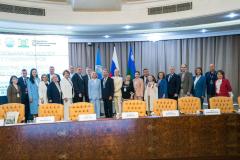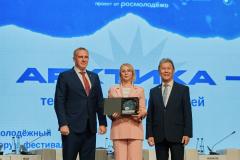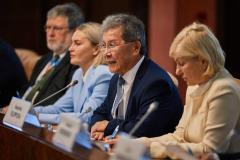Sakha Republic (Yakutia) is the largest federal subject of Russia located in the north-eastern part of Siberia, in the Far Eastern Federal District. Yakutsk is the capital city of the region.
The population of Yakutia is about 962,000 (2015), the area - 3,083,523 sq. km.
The capital city of Sakha Republic: Yakutsk.
Overview
Sakha Republic (Yakutia) is the largest federal subject of Russia located in the north-eastern part of Siberia, in the Far Eastern Federal District. Yakutsk is the capital city of the region.
The population of Yakutia is about 962,000 (2015), the area - 3,083,523 sq. km.
Flag and Coat of Arms


History
According to archaeological studies, ancient people inhabited the Lena River region in the early Paleolithic. A lot of archaeological monuments dated from 300,000 to 10,000 years ago were found. From the middle of the first millennium AD, the ancestors of the Evens and Evenks began to settle here. By the 13th century, the Tungusic tribes settled in the Middle Lena, Viluy, Olekma.
The arrival of the ancestors of the Yakuts or Sakha (endonym) forced them to move to the west and east of the Lena. Livestock development brought major changes in the economic life of the region. The Yakuts brought handicraft production (blacksmithing, jewelry, pottery etc.) and construction of permanent dwellings.
In the first quarter of the 17th century, the Cossacks reached the banks of the Lena River. The fortified settlements of Lensky (Yakutsk), Zhigansk, Verkhoyansk, Zashiversk, Srednekolymsk were founded. They became the advanced posts for Russian colonists, who moved to the northeast Asia.
Features
Yakutia is the largest administrative and territorial region in the world and the largest subject of the Russian Federation. Yakutia is larger than Argentina - the eighth largest country in the world. The territory of the republic stretches for 2,500 km from north to south and 2,000 km from west to east. The distance from Moscow to Yakutsk by roads is about 8,300 km.
Almost half of the region (about 40%) is located in the Arctic Circle. In the north the Sakha Republic is washed by the Laptev Sea and East Siberian Sea. The total length of the coastline exceeds 4,500 km. Yakutia is characterized by the diversity of natural conditions and resources.
The Republic of Sakha is often called the land of rivers (over 700,000) and lakes (over 800,000). The total length of all the rivers is about 2 million km. The largest navigable rivers are the Lena (4,400 km), Viluy (2,650 km), Olenek (2,292 km), Aldan (2,273 km), Kolyma (2,129 km), Indigirka (1,726 km), Olekma (1,436 km), Anabar (939 km), and Yana (872 km).
The climate is sharply continental with long winters and short summers. It is one of the coldest places in the world. The Cold Pole of the Northern Hemisphere is located in Oymyakon, one of the coldest permanently inhabited locales on Earth, in winter the temperature can drop below 65 degrees Celsius. April and October are winter months in Yakutia. Almost the entire territory of the region is located in the permafrost zone.
The national composition according to the 2010 Census: Yakuts (49.9%), Russians (37.8%), Evenks (2.2%), Ukrainians (2.2%), Evens (1.6%), Tatars (0.9%). The largest cities and towns are Yakutsk (304,000) Neryungri (57,700), Mirny (34,800), Lensk (23,600), Aldan (20,800). Yakutsk is the largest city in the world located in the permafrost zone.
State holidays of Yakutia:
- April 27 - Day of the Republic of Sakha (Yakutia),
- June 21-26 - National holiday Yhyakh (summer holiday),
- September 27 - Day of statehood of the Republic of Sakha (Yakutia).
Resources and Economy
Today, the Republic of Sakha (Yakutia) has a developed mining industry extracting gold, diamonds, oil, natural gas, coal, and various metals. Elkonskoye uranium deposit, the largest in Russia, is located here. Yakutia is also known for its furs and mammoth tusks.
The main industries are non-ferrous metallurgy, mining of diamonds and gold (about 90% of all Russian diamonds and 24% of gold), coal mining, forest and wood processing, light and food industries. The tourism industry is developing rapidly. Agriculture produces milk, meat, vegetables, furs, reindeer.
Most of the cargo is transported by waterways. In the navigation period, the main waterways are the Lena (with its tributaries the Vilyui and Aldan), Yana, Indigirka, and Kolyma. Goods to the northern districts of the republic are delivered by the Northern Sea Route.
In 2008, the federal highway “Kolyma” (Yakutsk-Magadan) was opened for year-round exploitation. Due to the low number of roads, air transport is relatively well developed. There are more than 30 airports in the republic.
Places of interest
Yakutia is one of the rare places on our planet with preserved primeval nature and an amazing variety of flora and fauna. The Republic of Sakha (Yakutia) has over 30% of Russian wildlife. More than 90% of the territory is unaffected or slightly affected by industrial development.
The main attractions of Yakutia are:
- Kisilyakh Mount (“stone people” in the Yakut language) is known for its picturesque piles of stones resembling blurry silhouettes of people.
- Lena and Sinskiye Pillars - two series of steep, vertical cliffs located 200 km from Yakutsk, on the banks of the Lena and Sinyaya rivers. These rocks have different fancy shapes: columns, spiers and towers. Many of them have traces of ancient rock paintings.
- Memorial Museum “Yakutsk political exile” in the village of Cherkyokh - an open-air museum that includes two dozen objects. The main purpose of the museum is to demonstrate how Russian culture, brought to Yakutia by political exiles, affected the lives of local people.
- Lensky historical and architectural museum-reserve “Druzhba” (“friendship”) in Sottintsy village, 70 km from Yakutsk, has interesting old wooden monuments, the oldest of them date back to the 17th century.
- Olekminsk Reserve - one of the most interesting nature reserves of Yakutia with a lot of bears, moose, deer and other wildlife.
- Lake Ulakhan-Ary-Kyuyele located on Ulakhan-Ary Island in Anabar national district.
- Ust-Vilyusky National Park located in the scenic valley between the rivers of Lyampushka and Dyanyshka, near Verkhoyansk Range.
- Zoo “Orto-Doydu”, located 50 km south of Yakutsk, has more than 150 animals (white-tailed eagles, golden eagles, spotted deer, Siberian tigers, Asian spruce grouse and others).
- Diamond quarry “Mir” in the town of Mirny is a man-made attraction. It is one of the largest quarries in the world with the diameter of 1,200 meters.






























